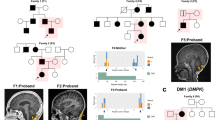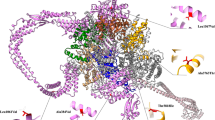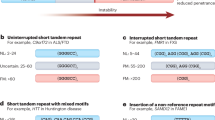Abstract
We report a case of a fetus with short-rib thoracic dysplasia (SRTD) with polydactyly that also presented with atypical severe acro-mesomelic ossification defects. Genetic analysis using massively parallel sequencing of a skeletal dysplasia panel revealed compound heterozygous variants in DYNC2H1. This clinical report highlights the challenges associated with diagnosing the diverse phenotypes in the SRTD group and emphasizes the importance of genetic surveillance with a targeted gene panel for accurate diagnosis.
Similar content being viewed by others
Short-rib thoracic dysplasia (SRTD) is a group of autosomal recessive disorders classified as skeletal disorders caused by abnormalities in cilia or ciliary signaling1. The characteristic findings include a narrow thoracic cage and short limbs with severe brachydactyly2,3,4,5. The narrowness of the thoracic cage is associated with death in infancy in affected individuals. In addition, SRTD data may include various visceral anomalies3. The diagnosis of SRTD is based on skeletal radiography and clinical findings. In the context of prenatal diagnosis, three-dimensional helical computed tomography4 or ultrasonography6,7 is also useful for detecting skeletal changes and internal malformations. Clinical and molecular studies of SRTD have revealed phenotypic diversity and overlap due to pathogenic variants in several genes3,8. In addition, SRTD patients may present several unusual phenotypes, and the genotype–phenotype correlation may be complicated by triallelic inheritance. Herein, we report a case of a terminated fetus whose skeletal abnormality was diagnosed as unclassifiable SRTD with unexpected molecular findings of biallelic variants in DYNC2H1, the most common disease-causing gene of SRTD.
A 36-year-old primipara woman was referred to the hospital at 15 weeks of gestation. Ultrasonography revealed extremely short limbs in her fetus. The femur measured 6.4 mm in length (−5.1 SD), the humerus was 7.4 mm (−6.1 SD), the tibia was 4.9 mm (−6.6 SD), and the radius was 5.0 mm (−6.2 SD) (SD presented is based on the Japanese fetal ultrasound reference9). The ulnae and short tubular bones were not identifiable. Other findings included a small thoracic cage, a single ventricle with pulmonary artery atresia, hyperechogenic kidneys, and megacystis. The pregnancy was terminated at 17 weeks of gestation. The terminated baby presented an extremely small thoracic cage, short arms and legs, especially distal segments, postaxial polydactyly, and brachydactyly (Fig. 1, left). Postmortem radiographs revealed generalized skeletal dysplasia with severe immaturity of the skeleton (Fig. 1, right). The thorax was severely narrow with short ribs. The ossification was defective in the vertebral bodies and ilia and absent in the pubic and ischial bones. The overall pattern was similar to that of SRTD types 3 or 1 caused by pathogenic variants in DYNC2H1, IFT80, WDR34, WDR60, and DYNC2LI11,4,5,7,10,11. In a normal fetus, ossification of the long bones is observed at 15 weeks of gestation, and the ulnae, fibulae, and short tubular bones are visible via X-ray12. However, in this case, the ossification of the ulnae and the fibulae was particularly immature, and the ossification of the short tubular bones was also absent. The selective severe ossification defect in the acro-mesomelic segments was atypical; thus, a tentative diagnosis of unclassifiable SRTD was made8,13.
Postaxial polydactyly and brachydactyly in the hands and feet are denoted with arrows. Right: Postmortem radiographs of the fetus showing generalized skeletal alterations with striking immaturity of the skeleton, including a severely narrow thorax with short ribs, defective ossification of the vertebral bodies and ilia, and absent ossification of the pubic and ischial bones. The long bones are severely short. The ulnae are particularly short, and the fibulae are not ossified. Ossification of the short tubular bones is absent.
We first performed clinical whole-genome sequencing (automated TruSeq DNA PCR-free library) on DNA obtained from the peripheral blood of the parents. Segregation analysis was performed via exome sequencing of fetal chorionic villi. Both fetal and parental DNA samples were sequenced on an Illumina NovaSeq 6000 (Illumina) with an average coverage of at least 30x at Clinical Genomics Science for Life Laboratory (Stockholm, Sweden) and analyzed in Scout using a targeted gene panel with known skeletal ciliopathy genes14. Variants were ranked according to inheritance pattern, variant effect on protein, location in the genomic sequence (encoding exons ±20 bp of intronic sequence), pathogenicity score, and minor allele frequency (MAF) <0.005 according to public and local databases.
We identified four variants in the fetus, including (1) compound heterozygous variants in DYNC2H1 (NM_001080463.2: c.3404 A > T (p.Glu1135Val) and c.5682_5683del (p.His1896Tyrfs*9), (2) a heterozygous variant in IFT140 (NM_014714.4: c.3602 G > A (p.Arg1201His) inherited from the mother, and (3) a heterozygous variant in IFT122 (NM_018262: c.457 A > C (p.Asn153His) inherited from the father. Pathogenicity scores and ClinVar numbers of the variants are presented in Table 1.
The paternally inherited variant c.5682_5683del of DYNC2H1 has previously been reported as a pathogenic variant of SRTD type 3 in a compound heterozygous state with c.9070 C > T (p.Arg3004Cys)15. In contrast, the maternal variant c.3404 A > T (p.Glu1135Val) has not been reported in affected individuals and is absent in gnomAD (https://gnomad.broadinstitute.org), JMorp (https://jmorp.megabank.tohoku.ac.jp) and our local database (Swedish in-house database, which contains 14,200 cases). Using in silico prediction tools, this missense variant is predicted to be deleterious (Table 1). According to the American College of Medical Genetics and Genomics and the Association for Molecular Pathology (ACMG/AMP) guidelines, this variant is classified as likely pathogenic (PM2, PM3, PP3, and PP4). The other two variants, c.3602 G > A in IFT140 and c.457 A > C in IFT122, are classified as being of uncertain significance (Table 1).
The DYNC2H1 gene on chromosome 11q22.3 encodes a subunit of the cytoplasmic dynein complex16. Homozygous or compound heterozygous DYNC2H1 pathogenic variants are known to cause SRTD type 3 or short-rib thoracic dysplasia (formerly asphyxiating thoracic dysplasia-Jeune syndrome)1,3,5,17. The radiographic presentation of the currently reported fetus was different from that of SRTD3 or short-rib thoracic dysplasia, mainly because of the defect mineralization of the long tubular bones. Triallelic inheritance is a well-recognized phenomenon in ciliopathies18,19, and the IFT122 and IFT140 variants may have contributed to the severity of the phenotype in this fetus. However, the available evidence is currently insufficient to determine the role of this variant in this disease.
In conclusion, we report an atypical phenotype in a fetus with SRTD with deficient ossification of tubular bones caused by pathogenic variants in the DYNC2H1 gene.
HGV database
The relevant data from this Data Report are hosted at the Human Genome Variation Database at https://doi.org/10.6084/m9.figshare.hgv.3471.
References
Unger, S. et al. Nosology of genetic skeletal disorders: 2023 revision. Am. J. Med. Gene A 191, 1164–1209 (2023).
Naumoff, P., Young, L. W., Mazer, J. & Amortegui, A. J. Short rib-polydactyly syndrome type 3. Radiology 122, 443–447 (1977).
Krakow, D. in Obstetric Imaging: Fetal Diagnosis and Care 2nd edn. (Elsevier, 2018).
Yamada, T. et al. Prenatal diagnosis of short-rib polydactyly syndrome type 3 (Verma-Naumoff type) by three-dimensional helical computed tomography. J. Obstet. Gynaecol. Res. 37, 151–155 (2011).
Cheng, C. et al. Compound heterozygous variants in DYNC2H1 in a foetus with type III short rib-polydactyly syndrome and situs inversus totalis. BMC Med. Genomics 15, 55 (2022).
Schramm, T. et al. Prenatal sonographic diagnosis of skeletal dysplasias. Ultrasound Obstet. Gynecol. 34, 160–170 (2009).
Fontana, P. et al. Early prenatal diagnosis of a recurrent case of short-rib thoracic dysplasia 3 due to compound heterozygosity for variations in the DYNC2H1 gene: an “ultrasound first” approach. J. Matern. Fetal Neonatal. Med. 36, 2205985 (2023).
Mill, P. et al. Human and mouse mutations in WDR35 cause short-rib polydactyly syndromes due to abnormal ciliogenesis. Am. J. Hum. Genet. 88, 508–515 (2011).
Japanese Society of Ultrasound in Medicine TaDCC. Standardization of ultrasound fetal measurements and Japanese reference values 2003. J. Med. Ultrason. http://www.jsum.or.jp/committee//diagnostic/pdf/taiji (2024).
Chen, L. S. et al. Identification of novel DYNC2H1 mutations associated with short rib-polydactyly syndrome type III using next-generation panel sequencing. Genet. Mol. Res. 15, gmr.15028134 (2016).
Xia, C. L. et al. Radiological and histopathological features of short rib‑polydactyly syndrome type III and identification of two novel DYNC2H1 variants. Mol. Med. Rep. 23, 426 (2021).
Offiah, A. C., Vockley, J., Munns, C. F. & Murotsuki, J. Differential diagnosis of perinatal hypophosphatasia: radiologic perspectives. Pediatr. Radio. 49, 3–22 (2019).
Kannu, P., McFarlane, J. H., Savarirayan, R. & Aftimos, S. An unclassifiable short rib-polydactyly syndrome with acromesomelic hypomineralization and campomelia in siblings. Am. J. Med. Genet. A 143A, 2607–2611 (2007).
Hammarsjö, A. et al. High diagnostic yield in skeletal ciliopathies using massively parallel genome sequencing, structural variant screening and RNA analyses. J. Hum. Genet. 66, 995–1008 (2021).
Okamoto, T. et al. Novel compound heterozygous mutations in DYNC2H1 in a patient with severe short-rib polydactyly syndrome type III phenotype. Congenit. Anom. 55, 155–157 (2015).
Dagoneau, N. et al. DYNC2H1 mutations cause asphyxiating thoracic dystrophy and short rib-polydactyly syndrome, type III. Am. J. Hum. Genet. 84, 706–711 (2009).
Short-rib thoracic dysplasia 3 with or without polydactyly; SRTD3 [Internet]. https://www.omim.org/entry/613091#:~:text=Short%2Drib%20thoracic%20dysplasia%20(SRTD,appearance%20of%20the%20acetabular%20roof (2024).
Katsanis, N. et al. Triallelic inheritance in Bardet-Biedl syndrome, a Mendelian recessive disorder. Science 293, 2256–2259 (2001).
Eichers, E. R., Lewis, R. A., Katsanis, N. & Lupski, J. R. Triallelic inheritance: a bridge between Mendelian and multifactorial traits. Ann. Med. 36, 262–272 (2004).
Acknowledgements
We thank the family for participating in the study. We acknowledge the Clinical Genomics Stockholm facility at the Science for Life Laboratory for providing expertise and service with sequencing analysis. G.G. is a member of the European Reference Network on Rare Congenital Malformations and Rare Intellectual Disability ERN-ITHACA [EU Framework Partnership Agreement ID: 3HP-HP-FPA ERN-01-2016/739516]. This study was partially supported by grants from the Ministry of Health, Labor and Welfare of Japan and the MHLW Research on Rare and Intractable Diseases Program Grant Number JPMH22FC1012 to Y.M. Financial support was also provided by grants from Stiftelsen Sällskapet Barnavård (to AH), Stiftelsen Promobilia, Stiftelsen Frimurare Barnhuset i Stockholm, the Swedish Research Council (2022-02647), Region Stockholm (2021-0855), and Karolinska Institutet (to G.G.).
Author information
Authors and Affiliations
Corresponding author
Ethics declarations
Ethics approval
This study was approved by the Institutional Review Board (IRB) of Asahikawa-Kosei General Hospital (no. 2023006) for reporting and by the Regional Ethical Review Board of Karolinska University Hospital and Karolinska Institutet (protocol numbers 2014/983-31/1, 2012/2106-31/4, 2018/2207-32, and 2021-05360) for genomic studies of rare diseases and skeletal dysplasia. Written informed consent for participation in the study and the publication of the patient’s clinical data and images was obtained from the parents.
Competing interests
The authors declare no competing interests.
Additional information
Publisher’s note Springer Nature remains neutral with regard to jurisdictional claims in published maps and institutional affiliations.
Rights and permissions
Open Access This article is licensed under a Creative Commons Attribution 4.0 International License, which permits use, sharing, adaptation, distribution and reproduction in any medium or format, as long as you give appropriate credit to the original author(s) and the source, provide a link to the Creative Commons licence, and indicate if changes were made. The images or other third party material in this article are included in the article’s Creative Commons licence, unless indicated otherwise in a credit line to the material. If material is not included in the article’s Creative Commons licence and your intended use is not permitted by statutory regulation or exceeds the permitted use, you will need to obtain permission directly from the copyright holder. To view a copy of this licence, visit http://creativecommons.org/licenses/by/4.0/.
About this article
Cite this article
Nakajima, E., Yokohama, Y., Sugiyama, S. et al. Unclassifiable short-rib thoracic dysplasia diagnosed using targeted gene panel sequencing. Hum Genome Var 11, 44 (2024). https://doi.org/10.1038/s41439-024-00302-y
Received:
Revised:
Accepted:
Published:
DOI: https://doi.org/10.1038/s41439-024-00302-y




